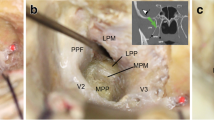Abstract
Purpose
Exposure of the cavernous sinus or anterior parahippocampus often involves a wide exposure of the temporal lobe and mobilization of the temporalis muscle associated with temporal lobe retraction. The authors present a cadaveric study to illustrate the feasibility, advantages and landmarks necessary to perform a trans-zygomatic middle fossa approach to lesions around the cavernous sinus and anterior parahippocampus.
Methods
The authors performed bilateral trans-zygomatic middle fossae exposures to reach the cavernous sinus and parahippocampus in five cadavers (10 sides). We assessed the morbidity associated with this procedure and compared the indications, advantages, and disadvantages of this method versus more extensive skull base approaches. A vertical linear incision along the middle portion of the zygomatic arch was extended one finger breadth inferior to the inferior edge of the zygomatic arch. Careful dissection inferior to the arch allowed preservation of facial nerve branches. A zygomatic osteotomy was followed via a linear incision through the temporalis muscle and exposure of the middle cranial fossa floor.
Results
A craniotomy along the inferolateral temporal bone and middle fossa floor allowed extradural dissection along the middle fossa floor and exposure of the cavernous sinus including all three divisions of the trigeminal nerve. Intradural inspection demonstrated adequate exposure of the parahippocampus. Exposure of the latter required minimal or no retraction of the temporal lobe.
Conclusions
The trans-zygomatic middle fossa approach is a simplified skull base exposure using a linear incision, which may avoid the invasivity of more extensive skull base approaches while providing an adequate corridor for resection of cavernous sinus and parahippocampus lesions. The advantages of this approach include its efficiency, ease, minimalism, preservation of the temporalis muscle, and minimal retraction of the temporal lobe.








Similar content being viewed by others
References
Al-Mefty O, Anand VK (1990) Zygomatic approach to skull-base lesions. J Neurosurg 73:668–673
Ammirati M, Ma J, Becker D, Black K, Cheatham M, Bloch J (1992) Transzygomatic approach to the tentorial incisurae: surgical anatomy. Skull Base Surg 2:161–166. doi:10.1055/s-2008-1057128
Becker D, Ammirati M, Black K, Canalis R, Andrews J (1991) Transzygomatic approach to tumours of the parasellar region. Technical note. Acta Neurochir (Wien) Suppl 53:89–91
Fisch U, Pillsbury HC (1979) Infratemporal fossa approach to lesions in the temporal bone and base of the skull. Arch Otolaryngol 105:99–107
Gates GA (1988) The lateral facial approach to the nasopharynx and infratemporal fossa. Otolaryngol Head Neck Surg 99:321–325
Honeybul S, Neil-Dwyer G, Lang DA, Evans BT, Lees PD (1995) The transzygomatic approach: a long-term clinical review. Acta Neurochir (Wien) 136:111–116. doi:10.1007/BF01410611
Liu JK, Fukushima T, Sameshima T, Al-Mefty O, Couldwell WT (2006) Increasing exposure of the petrous internal carotid artery for revascularization using the transzygomatic extended middle fossa approach: a cadaveric morphometric study. Neurosurgery 59 [Suppl]:ONS309–ONS319
Sekhar LN, Shramm VL, Jones NF (1987) Subtemporal-preauricular infratemporal fossa approach to large lateral and posterior cranial base neoplasms. J Neurosurg 67:488–499
Shelden CH et al (1955) Compression rather than decompression for trigeminal neuralgia. J Neurosurg 12:123–126
Terasaka S, Sawamura Y, Goto S, Fukushima T (1999) A lateral transzygomatic transtemporal approach to the infratemporal fossa: Technical Note for mobilization of the second and third branches of the trigeminal nerve. Skull Base Surg 9:277–287. doi:10.1055/s-2008-1058138
Uttley D, Archer DJ, Marsh HT, Bell BA (1991) Improved access to lesions of the central skull base by mobilization of the zygoma: experience with 54 cases. Neurosurgery 28:99–103. doi:10.1097/00006123-199101000-00015
Author information
Authors and Affiliations
Corresponding author
Additional information
Comment
The authors describe a less invasive approach to the lateral cavernous sinus and medialtemporal region using a small lateral temporal window and a subtemporal approachthrough a linear incision. The approach does have merit, but has been well described previously. C. Hunter Shelden popularized a subtemporal approach to the gasserian ganglion in the 1950s. This was used by many surgeons, including Poppen to treat trigeminal neuralgia by direct compression of the ganglion. The operation was performed using a linear temporal incision as described. The current publication reminds us of the advantages of this approach to the cavernous sinus.
W.T. Couldwell
Utah, USA
Rights and permissions
About this article
Cite this article
Melamed, I., Tubbs, R.S., Payner, T.D. et al. Trans-zygomatic middle cranial fossa approach to access lesions around the cavernous sinus and anterior parahippocampus: a minimally invasive skull base approach. Acta Neurochir 151, 977–982 (2009). https://doi.org/10.1007/s00701-009-0376-4
Received:
Accepted:
Published:
Issue Date:
DOI: https://doi.org/10.1007/s00701-009-0376-4




